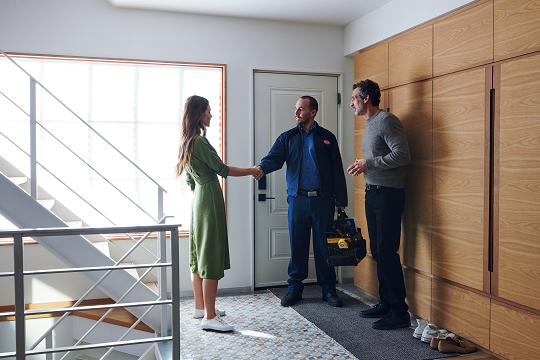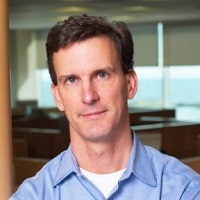ecobee was started in 2007 with one goal: to create an automated thermostat to keep interiors warm in winter and cool in summer while helping people conserve energy, save money and reduce their environmental footprint—all at the same time.
On average, heating and cooling accounts for up to 50% of a home’s energy use. Before we launched our Toronto-based company, there were only a few programmable thermostats on the market. Those early designs were hard to use, unreliable and not connected to the rest of your life.

A truly “smart” thermostat
We created a Wi-Fi-connected thermostat that can be controlled by your phone and can tap into data on the internet, including current weather conditions and electricity prices, to heat and cool your home more efficiently. We also offer voice-activated thermostats that not only allow you to change your home’s temperature, but turn on music or call a friend, and wireless room sensors that measure temperature and room occupancy to help even out hot and cold spots.
Sustainability isn’t about sacrifice. It’s about creating better products that are better for the environment. We believe that given the right tools, people have the power to change the world.
Our NFL regional strategy
Our two biggest competitors in the market are Honeywell and Google. It was a daunting challenge for a small Canadian start-up like us to try and compete with these multi-billion-dollar global companies. Many people thought we wouldn’t be able to do it. We were rejected for venture capital financing 174 times. To build our market in the United States, we worked hard to set an incredibly high bar for quality and satisfaction with our customers, so that they would advocate on our behalf.
We started with a regional approach by choosing U.S. cities that were big enough to support a National Football League (NFL) team. From the list of 32 NFL cities, we selected 12 based on factors such as energy prices, climate, population and the ratio of homeowners to renters. For example, New York City, while home to the NFL’s Giants, is not a great market for us because of the high proportion of renters, who are less likely to buy our product than homeowners.

Building trust one contractor at a time
Once we selected the regions, we entered the market through the heating and cooling service channel. We spent a lot of time driving around with contractors to understand how they work and what they care about. It was clear they weren’t going to buy products without seeing somebody from the “mothership.” Ultimately, they feel like they’re responsible for their customers’ equipment, so trust in the equipment and the supplier is very important.
Once we felt like we had done enough work to understand the challenges people run into when installing our products and we felt like we could adequately service them by phone, we launched in retail. We got calls from Best Buy, Home Depot and Apple all within two to three weeks of each other, so our launch was very successful.
We believe our customers have saved 7.64 terawatt hours of energy, that’s equivalent to taking all the homes in Seattle, Washington off the grid for a year!
EDC is an equity investor in ecobee and they’ve been a phenomenal partner, both from providing cash to help us build and grow the business.
Sustainability, data and donations
One of our core mandates is to find ways to live more sustainably. My ideas around sustainability were influenced by Ray Anderson’s book, Confessions of a Radical Industrialist. Sustainability is often equated with “the product doesn’t work as well and is more expensive.” Like Anderson, we’ve tried to prove this isn’t the case. In fact, sustainability is about doing more with less.
One of the ways we’ve helped demonstrate this truth is through ecobee’s Donate your data portal. When we were building the company and doing research into energy efficiency, we discovered there really wasn’t a great deal of good research into how people use energy in their homes. A typical study focuses on just three or four homes because it’s too expensive to do more than that.
We decided to partner with our customers and asked them to anonymously donate their data to our researchers. The anonymous data from ecobee’s millions of connected thermostats in all regions of North America provided researchers with a lot of helpful information. For example, researchers for the state of Indiana used our data to point out that using connected thermostats could save ratepayers from US$73 million to US$344 million over 10 years and reduce the need to construct a new power plant costing hundreds of millions of dollars.
We also believe that ecobee’s technology and the benefits it brings should be accessible to everyone. That’s why we partner with local housing organizations, cities, and non-governmental organizations to find effective ways to put our technology to work in the communities where it’s needed most. We recently donated more than 700 of our smart thermostats for a pilot project in four Toronto Community Housing buildings, allowing residents to control the temperature in their individual units for the first time. The pilot project demonstrated annual savings in heating costs between 8.8% to 11.8% while also greatly improving the comfort of residents.
Size doesn’t matter
When I think about what we set out to achieve when we started, it wasn’t about market growth or the size of the business. Those things will come if you have focus and consistently execute at a high level. Rather, it was to build a company that people will admire. We’re focused on building a great company—a place that recruits great people and builds products that our customers love. That’s what is most exciting to me.
How EDC helped
EDC is an equity investor in ecobee and they’ve been a phenomenal partner, both from providing cash to help us build and grow the business and also a sound resource for ideas and advice that really helped us grow the company beyond 500 people and millions of dollars being invested in the Canadian economy.








